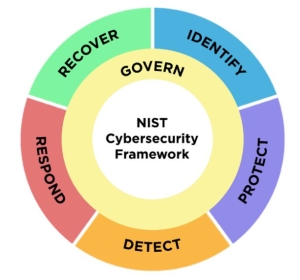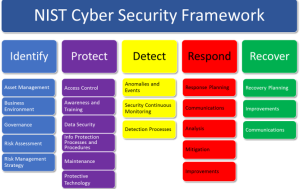How to Strengthen Your Cybersecurity Defenses
In today’s digital age, cybersecurity is paramount for businesses of all sizes. Small and medium-sized enterprises (SMEs) are particularly vulnerable to cyber threats due to their limited resources and often lack of dedicated IT security teams. To address these challenges, the National Institute of Standards and Technology (NIST) has developed a comprehensive cybersecurity framework which can be tailored to businesses of all sizes. In this article, we’ll explore what the NIST Cybersecurity Framework is, its benefits, how it applies to SMEs, and the best practices for implementing it.
What is the NIST Cybersecurity Framework?
The NIST Cybersecurity Framework (CSF), which is internationally recognized, is a set of guidelines, best practices, and standards designed to help organizations manage and improve their cybersecurity posture. It provides a flexible and customizable approach to cybersecurity that can be adapted to the specific needs and resources of businesses of all sizes. The framework consists of five core functions: Identify, Protect, Detect, Respond, and Recover.
Identify: Understand and prioritize your organization’s cybersecurity risks, assets, and vulnerabilities.
Protect: Implement safeguards to protect your systems, data, and networks from cyber threats.
Detect: Develop and deploy mechanisms to detect cybersecurity events in a timely manner.
Respond: Develop and implement response plans to effectively address cybersecurity incidents.
Recover: Develop and implement plans to restore and recover from cybersecurity incidents, minimizing their impact on business operations.
Govern: (Upcoming in 2024) Establish and monitor the organization’s cybersecurity risk management strategy, expectations, and policy.
NIST Cybersecurity Framework for SMEs
NIST Cybersecurity Framework – The Five Functions
What are the key attributes of the NIST CSF?
The NIST Cybersecurity Framework (CSF) is characterized by several key attributes that make it a valuable tool for organizations seeking to enhance their cybersecurity posture:
- Risk-Based Approach: The framework is built on the concept of risk management, allowing organizations to identify, assess, and prioritize cybersecurity risks based on their potential impact on business operations and objectives.
- Flexibility: The NIST CSF provides a flexible and customizable framework that can be adapted to the unique needs, resources, and risk profiles of different organizations across various industries and sectors.
- Comprehensive Coverage: It encompasses five core functions—Identify, Protect, Detect, Respond, and Recover—that collectively address the full spectrum of cybersecurity activities, from risk assessment and prevention to incident response and recovery.
- Framework for Collaboration: The NIST CSF serves as a common language and framework for collaboration between different stakeholders, including business leaders, IT professionals, cybersecurity experts, and regulators, fostering a holistic and coordinated approach to cybersecurity.
- Alignment with Standards and Best Practices: It aligns with various cybersecurity standards, guidelines, and best practices, such as ISO 27001, NIST SP 800-53, and COBIT, making it easier for organizations to demonstrate compliance and interoperability with existing frameworks.
- Continuous Improvement: The framework promotes a culture of continuous improvement by encouraging organizations to regularly assess and refine their cybersecurity practices in response to changing threats, technologies, and business requirements.
- Practical Guidance: It provides practical guidance, tools, and resources to help organizations implement cybersecurity best practices effectively, including risk assessment methodologies, control frameworks, and measurement criteria.
- Scalability: The NIST CSF is scalable, allowing organizations to start small and gradually expand their cybersecurity capabilities over time as their needs and resources evolve.
What are the benefits of the NIST Cybersecurity Framework?
Overall, implementing the NIST CSF will greatly strengthen an SME’s cybersecurity resilience with the following key benefits:
- Risk Management: By identifying and prioritizing cybersecurity risks, SMEs can allocate resources more effectively to mitigate these risks and protect their business assets.
- Compliance: The NIST CSF aligns with various regulatory requirements and industry standards, helping SMEs demonstrate compliance and build trust with customers and partners.
- Resilience: By adopting a proactive approach to cybersecurity, SMEs can enhance their resilience against cyber threats and minimize the potential impact of security incidents on their operations.
- Business Continuity: A robust cybersecurity program can help SMEs ensure business continuity by minimizing disruptions caused by cyber incidents and accelerating recovery efforts.
How does an SME apply the NIST Cybersecurity Framework?
While the NIST cybersecurity framework is comprehensive, SMEs may face unique challenges when applying it to their business. An experienced professional, such as a vCIO, can help SMEs efficiently implement the program. Here are some tips for applying the framework effectively:
- Assess Your Current State: Start by conducting a thorough cybersecurity risk assessment to identify your organization’s strengths, weaknesses, and areas for improvement.
- Strategic Plan: Create a strategic direction to align the NIST framework with the organization’s business objectives and risk management strategy.
- Customize the Framework: Tailor the NIST CSF to fit the specific needs and resources of your SME. Focus on implementing controls and practices that provide the most value and address your highest-priority risks.
- Engage Leadership and Employees: Cybersecurity is everyone’s responsibility. Engage leadership buy-in and provide cybersecurity training and awareness programs to employees to ensure they understand their roles and responsibilities.
- Implement Security Controls: Deploy technical safeguards such as firewalls, antivirus software, MFA/2FA, backup and recovery, and encryption to protect your IT infrastructure. Additionally, establish policies and procedures for managing access controls, data protection, and incident response.
- Technical Expertise: Appropriate deployment of cybersecurity controls and solutions, ensuring they are implemented correctly and integrated seamlessly with existing IT infrastructure.
- Monitor and Review: Continuously monitor your cybersecurity controls and processes, and regularly review, test, and update your cybersecurity program to adapt to evolving threats and business needs.
Conclusion
In conclusion, the NIST cybersecurity program can provide SMEs with a practical and effective framework for managing and improving their cybersecurity posture. By adopting the NIST CSF and implementing best practices, SMEs can strengthen their resilience against cyber threats, demonstrate compliance with regulatory requirements, and safeguard their business operations and reputation. With cyber threats on the rise, investing in cybersecurity is not only essential for protecting your SME but also for ensuring its long-term success and growth.
